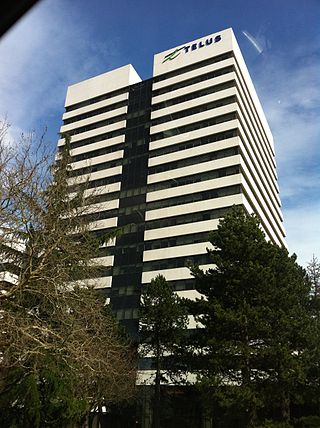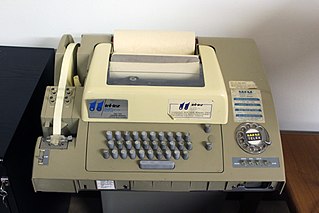Related Research Articles

Alexander Graham Bell was a Scottish-born Canadian-American inventor, scientist, and engineer who is credited with patenting the first practical telephone. He also co-founded the American Telephone and Telegraph Company (AT&T) in 1885.

Electrical telegraphy is a point-to-point text messaging system, primarily used from the 1840s until the late 20th century. It was the first electrical telecommunications system and the most widely used of a number of early messaging systems called telegraphs, that were devised to send text messages more quickly than physically carrying them. Electrical telegraphy can be considered the first example of electrical engineering.

A telephone, colloquially referred to as a phone, is a telecommunications device that enables two or more users to conduct a conversation when they are too far apart to be easily heard directly. A telephone converts sound, typically and most efficiently the human voice, into electronic signals that are transmitted via cables and other communication channels to another telephone which reproduces the sound to the receiving user. The term is derived from Ancient Greek: τῆλε, romanized: tēle, lit. 'far' and φωνή, together meaning distant voice.

Telus Communications Inc. (TCI) is the wholly owned principal subsidiary of Telus Corporation, a Canadian national telecommunications company that provides a wide range of telecommunications products and services including internet access, voice, entertainment, healthcare, video, smart home automation and IPTV television. The company is based in the Vancouver, British Columbia, area; it was originally based in Edmonton, Alberta, before its merger with BC Tel in 1999. Telus' wireless division, Telus Mobility, offers UMTS, and LTE-based mobile phone networks. Telus is the incumbent local exchange carrier in British Columbia and Alberta. Its primary competitors are Rogers Communications and Bell Canada. Telus is a member of the British Columbia Technology Industry Association.

Optical communication, also known as optical telecommunication, is communication at a distance using light to carry information. It can be performed visually or by using electronic devices. The earliest basic forms of optical communication date back several millennia, while the earliest electrical device created to do so was the photophone, invented in 1880.

Antonio Santi Giuseppe Meucci was an Italian inventor and an associate of Giuseppe Garibaldi, a major political figure in the history of Italy. Meucci is best known for developing a voice-communication apparatus that several sources credit as the first telephone.

The Communications Workers of America (CWA) is the largest communications and media labor union in the United States, representing about 700,000 members in both the private and public sectors. The union has 27 locals in Canada via CWA-SCA Canada representing about 8,000 members. CWA has several affiliated subsidiary labor unions bringing total membership to over 700,000. CWA is headquartered in Washington, DC, and affiliated with the AFL–CIO, the Strategic Organizing Center, the Canadian Labour Congress, and UNI Global Union.
The International Brotherhood of Electrical Workers (IBEW) is a labor union that represents approximately 820,000 workers and retirees in the electrical industry in the United States, Canada, Guam, Panama, Puerto Rico, and the US Virgin Islands; in particular electricians, or inside wiremen, in the construction industry and lineworkers and other employees of public utilities. The union also represents some workers in the computer, telecommunications, and broadcasting industries, and other fields related to electrical work.

Communications, Energy and Paperworkers Union of Canada was a largely private-sector labour union with 150,000 members, active from 1992 to 2013. It was created in 1992 through the merger of three unions: the Canadian Paperworkers Union, the Communications and Electrical Workers of Canada, and the Energy and Chemical Workers Union. See below for some other unions that were merged into the CEP. CEP was affiliated to the Canadian Labour Congress.
Signalling System R2 is a signalling protocol for telecommunications that was in use from the 1960s mostly in Europe, and later also in Latin America, Asia, and Australia, to convey exchange information between two telephone switching systems for establishing a telephone call via a telephone trunk. It is suitable for signaling on analog as well as digital circuits.

The Bell Telephone Company was the initial corporate entity from which the Bell System originated to build a continental conglomerate and monopoly in telecommunication services in the United States and Canada.

The history of telecommunication began with the use of smoke signals and drums in Africa, Asia, and the Americas. In the 1790s, the first fixed semaphore systems emerged in Europe. However, it was not until the 1830s that electrical telecommunication systems started to appear. This article details the history of telecommunication and the individuals who helped make telecommunication systems what they are today. The history of telecommunication is an important part of the larger history of communication.
Section 92(10) of the Constitution Act, 1867, also known as the works and undertakings power, grants the provincial legislatures of Canada unless otherwise noted in section (c), the authority to legislate on:
10. Local Works and Undertakings other than such as are of the following Classes:

This history of the telephone chronicles the development of the electrical telephone, and includes a brief overview of its predecessors. The first telephone patent was granted to Alexander Graham Bell in 1876.

Alexander Graham Bell was an inventor, scientist, and engineer who received numerous honors and tributes during his life, and new awards were subsequently named for him posthumously.

Telex is a telecommunication system that allows text-based messages to be sent and received by teleprinter over telephone lines. The term "telex" may refer to the service, the network, the devices, or a message sent using these. Telex emerged in the 1930s and became a major method of sending text messages electronically between businesses in the post–World War II period. Its usage declined as the fax machine grew in popularity in the 1980s.
The Program on Information Resources Policy (PIRP) was a research program at Harvard University, sometimes referred to informally as "Harvard's think tank on the information age." See for a complete explanation. It was established on February 1, 1973 by Anthony Oettinger and John LeGates and closed on June 30, 2011 by the same principals. It worked in the realm of communications and information resources. At most points in its history it employed as many as 15 full time staffers, mostly professionals, as well as hosting scores of visiting scholars and sponsored researchers over the years. At any given time it was supported by about 100 different public and private organizations.

Telecommunication, often used in its plural form or abbreviated as telecom, is the transmission of information over a distance using electronic means, typically through cables, radio waves, or other communication technologies. These means of transmission may be divided into communication channels for multiplexing, allowing for a single medium to transmit several concurrent communication sessions. Long-distance technologies invented during the 20th and 21st centuries generally use electric power, and include the telegraph, telephone, television, and radio.
Glenn Ellis Watts was an American labor union leader.
The Communications and Electrical Workers of Canada (CWC) was a Canadian trade union.
References
- 1 2 Rideout, Vanda (2003). Continentalizing Canadian Telecommunications. McGill-Queen's University Press. ISBN 9780773524255.
- ↑ "Fonds RC0163 – International Union of Electrical, Radio and Machine Workers. Canadian District". McMaster University. Retrieved 23 October 2023.